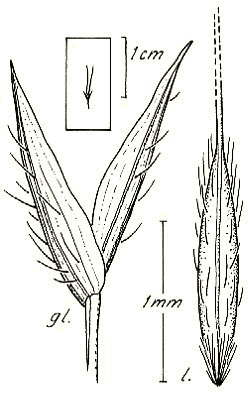Eriachne minuta M. Lazarides. Austral.
Syst. Bot. 8: 395 (1995).
Classification. (GPWG 2001) : Subfamily
Micrairoideae. Eriachneae.
Type of Basionym or
Protologue Information: Australia, Kakadu Nat. Park: Dunlop 4849 (CANB
holo, BRI, DNA, NT).
Key references
(books and floras): [2002] D.Sharp & B.K.Simon, AusGrass, Grasses of
Australia.
Illustrations:
[2005] K.Mallet (ed.), Flora of Australia 44B: Poaceae 3 (Fig
28A-B).
Habit. Annual
or ephemeral. Culms erect or geniculately ascending, 4.5–15 cm tall, 2–3
-noded. Mid-culm internodes glabrous. Mid-culm nodes glabrous. Lateral branches
branched. Ligule a fringe of hairs, 0.5 mm long. Leaf-blades conduplicate or
involute or convolute, 2–3 mm wide. Leaf-blade surface indumented.
Inflorescence.
Inflorescence compound, a panicle. Panicle oblong, 3–6 cm long, 1–4 cm wide.
Spikelets.
Spikelets pedicelled. Fertile spikelets 2-flowered, both fertile, comprising 2
fertile floret(s), without rachilla extension, ovate, laterally compressed,
1.5–1.8 mm long.
Glumes. Glumes
similar, thinner than fertile lemma. Lower glume lanceolate, membranous, much
thinner on margins, without keels, 3 -nerved. Lower glume surface indumented.
Upper glume lanceolate, 1.5–1.8 mm long, membranous, without keels, 3 -nerved.
Upper glume surface indumented.
Florets.
Fertile lemma 1.3–1.8 mm long, without keel, 3 -nerved. Lemma surface glabrous
or indumented. Lemma apex awned, 1 -awned. Median (principal) awn 3.3–5.5 mm
long overall. Palea 2 -nerved. Palea apex entire or dentate, muticous.
Lodicules present. Anthers 3. Grain 1 mm long.
Continental Distribution:
Australasia.
Australian
Distribution: Northern Territory.
Northern Territory:
Darwin & Gulf.
Notes.
Distinguished by its delicate short-lived habit, stiff indumentum on foliage
and inflorescence, open prominently exserted panicles, extremely small
spikelets, minute subacute bearded callus, three-nerved hairy glumes, subequal
(to glumes) florets with appressed lemma and palea, awned lemmas ciliate on
margins and without grooves, and glabrous muticous entire paleas. A distinctive
species apparently isolated in its relationships.
Endemic.
N.T. N of 15ºS. Damp or seasonally wet sites, in shallow or deep sand or
organic matter, often in or near small watercourses or in seepage, and
sometimes in cracks in sandstone escarpment, rock faces, and on outcrops.
Flowers and fruits Apr.-July (mid-autumn to mid-winter).



